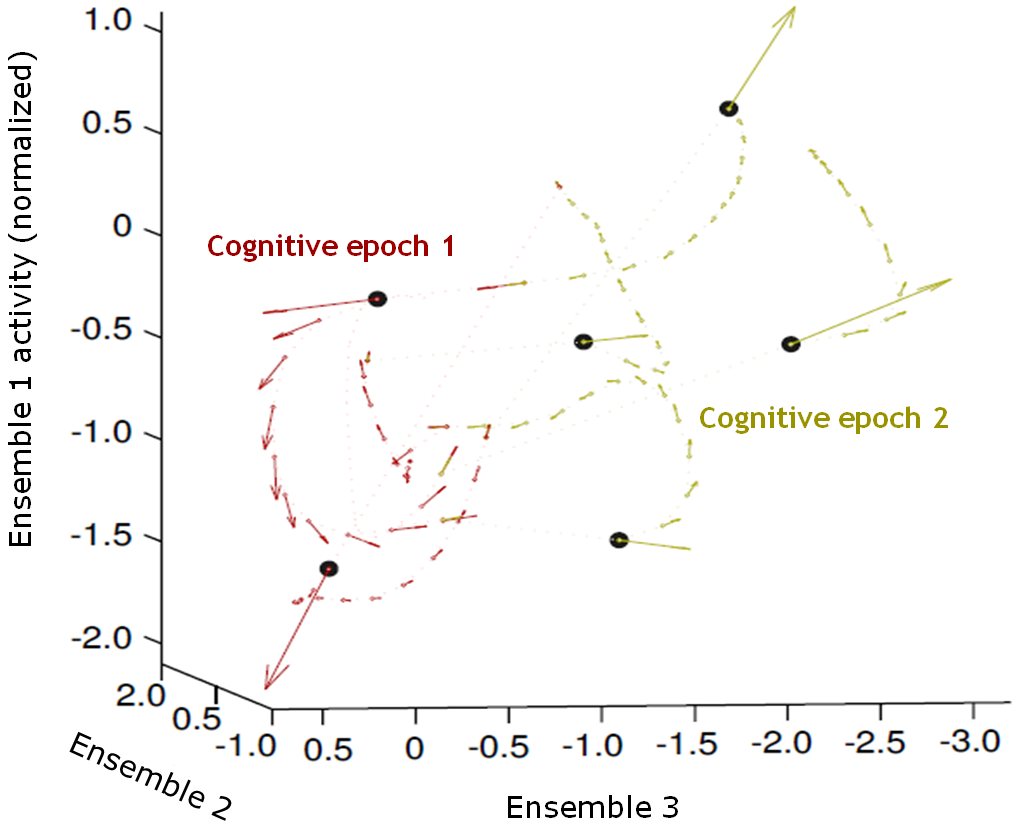Main research directions
Inferring neural ensemble dynamics
We focus in the identification of metastable neural ensemble activity dynamics on a trial by trial basis. Towards this goal, we use in-vivo multiple single-unit recordings and local field potentials besides a range of electrophysiological and neural imaging approaches.
 Attractors are regions of the state space spanned by the biophysical variable of the system (such as for instance the activity of simultaneously recorded ensembles of neurons) where trajectories tend to concentrate and are stable under subtle perturbations; and constitute an essential theoretical concept underlying our contemporary models of perception and high cognitive functions.
However, the existence of such stable states is very difficult to be proven empirically; and they may be partially an epiphenomenon temporary induced by either external inputs or the intrinsic characteristics of the network dynamics, even if is fundamentally unstable. Thus, recently, some authors rather refer to them as metastable states.
We are currently developing algorithms and models in order to identify empirically regions of metastability in state spaces spanned by neural and synaptic variables.
Our analyses are designed to help in understanding neural ensemble dynamics by liking phenomenological and modelling approaches in normal and pharmacologically altered conditions; which seem to furnish the dynamical basis of e.g. perception, decision making or working memory.
Attractors are regions of the state space spanned by the biophysical variable of the system (such as for instance the activity of simultaneously recorded ensembles of neurons) where trajectories tend to concentrate and are stable under subtle perturbations; and constitute an essential theoretical concept underlying our contemporary models of perception and high cognitive functions.
However, the existence of such stable states is very difficult to be proven empirically; and they may be partially an epiphenomenon temporary induced by either external inputs or the intrinsic characteristics of the network dynamics, even if is fundamentally unstable. Thus, recently, some authors rather refer to them as metastable states.
We are currently developing algorithms and models in order to identify empirically regions of metastability in state spaces spanned by neural and synaptic variables.
Our analyses are designed to help in understanding neural ensemble dynamics by liking phenomenological and modelling approaches in normal and pharmacologically altered conditions; which seem to furnish the dynamical basis of e.g. perception, decision making or working memory.
The projects in this research direction are conducted in collaboration with Chris Lapish (Indiana Purdue University), Maria Victoria Sanchez-Vives (University of Barcelona) and Daniel Durstewitz (University of Heidelberg).
Selected publications in this area
Amphetamine exerts dose-dependent changes in Prefrontal Cortex Attractor Dynamics during Working Memory. Lapish, C., Balaguer-Ballester, E., (shared first authorship), Seamans, J., Phillips, A. and Durstewitz, D. 2015. The Journal of Neuroscience, 35(28) 10172-10187. (bibTeX)
Can we identify non-stationary dynamics in trial-to-trial variability? Balaguer-Ballester, E., Tabas-Diaz, A, and Budka, M. 2014. PLoS ONE, 9(4):e95648. (bibTeX)
Multi-site reproducibility of prefrontal-hippocampal connectivity estimates by stochastic dynamic causal models. Bernal-Casas D, Balaguer-Ballester E, Gerchen M, Iglesias S, Walter H, Heinz A, Meyer-Lindenberg A, Stephan KE, Kirsch P. 2013. Neuroimage, 82: 555-563. (bibTeX)
Contextual encoding by ensembles of medial prefrontal cortex neurons. Hyman J, Ma L, Balaguer-Ballester E., Durstewitz D and Seamans J. 2012. PNAS, 109(13) 5086-5091 (bibTeX)
Attracting dynamics of frontal cortex ensembles during memory-guided decision making. Balaguer-Ballester, E., Lapish, C., Seamans, J. and Durstewitz, D. 2011. PLoS Computational Biology, 7(5): e1002057. (bibTeX)
Statistical Approaches for Reconstructing Neurocognitive Ensemble Dynamics from High-Dimensional Neural Recordings. Durstewitz, D. and Balaguer-Ballester, E. 2010. Neuroforum, 4 (10): 266-276 (bibTeX)
For an exahustive list please see Research Gate
Neurocomputational modelling
We are developing anatomically specific and biophysically realistc models in order to underpin neural and synaptic mechanisms mediating bottom-up and top-down hierarchical processing of auditory stimuli. To these means we are using electro- and magneto- encephalographic recordings (EEG, MEG) in humans. Our modelling approaches are also applied to cognitive control and interpersonal processing using EEG and functional brain-imaging resonance data (fMRI).

How does our brain produce an effortless and almost immediate representation of sounds? The quick identification of a speaker’s voice or a subtle change in a pitch of a tune requires the instantaneous disentanglement of sophisticated auditory cues in the millisecond range. To understand this mechanism major challenge for theories based on bottom-up sound processing. We are primarily interested in understanding how high levels of the auditory hierarchy can generate a very quick conscious perception of complex sound attributes such as, for instance, the melodic pitch. Our hypothesis is that attention to one specific acoustic feature e.g. frequency details of the sound) travels hierarchy back down to the level where these details are present and hence modulate the neural responses in this area in order to refine the following feedforward processing. We are developing biophysically realistic models which are designed to help in our understanding of central auditory processing in normal and altered conditions.
The projects regarding auditory perception modelling are conducted in collaboration with Andre Rupp (University of Heidelberg); and Ben Parris and Xun He in the context of higher cognitive functions (Bournemouth University).
Selected publications in this area
Insights on the Neuromagnetic Representation of Temporal Asymmetry in Human Auditory Cortex Tabas A, Siebert A, Supek S, Pressnitzer D, Balaguer-Ballester E, Rupp A, (Joint last author) 2016. PLoS One, 11(4): e0153947. doi:10.1371/journal.pone.0153947. (bibTeX)
Understanding pitch perception as a hierarchical process with top-down modulation. Balaguer-Ballester, E., Clark, N., Coath, M., Krumbholz, K. and Denham, S. L. 2009. PLoS Computational Biology, 5: e1000301. (bibTeX)
A cascade autocorrelation model of pitch perception. Balaguer-Ballester, E., Denham, S. L. and Meddis, R. 2008. Journal of the Acoustic Society of America, 124: 2186-2195. (bibTeX)
A model of perceptual segregation based on clustering the time series of the simulated auditory nerve firing probability. Balaguer-Ballester, E., Coath, M. and Denham, S. L. 2007. Biological Cybernetics, 97: 479-491. (bibTeX)
The linearity of emergent spectro-temporal receptive fields in a model of auditory cortex. Coath, M., Balaguer-Ballester E., and Denham, S. L. 2007. Biosystems, 89: 182-189. (bibTeX)
